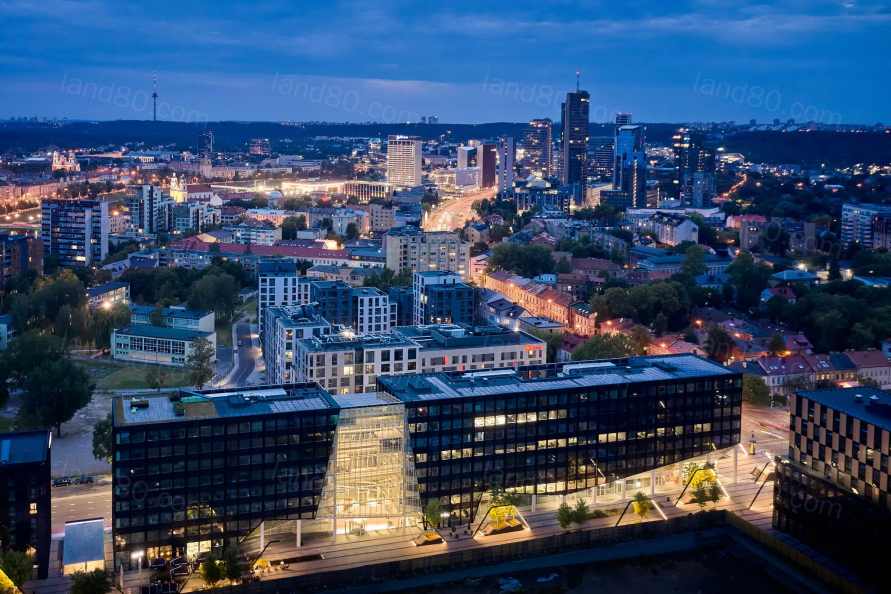多年来,老体育场的记分牌在雾蒙蒙的维尔纽斯市中心上空闪闪发光,告知人们一个不寻常的事件发生,并吸引了大量的市民,--"1:0 "或也许 "GOAL!"?那个深色的、像素状的记分牌结构是城市轮廓的组成部分,在城市记忆中起着重要的作用。
The scoreboard of the old stadium shone above the misty Vilnius city center for many years, informing about an unusual events happening and attracting crowds of citizens, - “1:0” or maybe “GOAL!”? That dark, pixel-shaped structure of the scoreboard was the integral part of the city’s silhouette and played an important role in urban memory.





我们决定利用这一强烈的形象参加在原体育场所在地举行的建筑办公楼竞标。原有的不朽的、像素化的立面和躺着的方尖碑式的结构,沿着城市最重要的动脉之一定居。对我们来说,重要的是创造一个外向的综合体,让光线和人流畅地穿过建筑,让人们找到一个休闲、工作和观察城市生活的地方。
We decided to take advantage of this strong image by participating in architectural office building competition that was held on the site of the former stadium. The original monumental, pixelated façade and lying obelisk-like structure, settled along one of the city’s most important arteries. It was important for us to create an extravertal complex that lets the light and people flow fluently through the building, allowing to find a place for recreation, work and observation of urban city life.



近180米长的建筑结构被中庭的体积所分割。中庭位于西面街道的城市轴线上,让阳光照亮东面的广场。主入口设在北侧,那里最大的体量在角落里形成了最大的空间开口。所有的 "切口"都是由透明的漂白玻璃制成。这样的明暗效果不仅有助于识别入口点,而且在视觉上将体量划分为若干部分,体量在规模上变得有背景。
Nearly 180 m long structure of the building was divided by the volume the atrium. The atrium settled on the urban axis from the street on the west letting the sun to illuminate the square on the east. The main entrance is provided on the north side, where the largest volume cut on the corners forms the maximum opening to the space. All "cutouts" are made of clear, bleached glass. Such a light-dark effect not only helps to identify points of access, but also optically divides the volume into parts - volume becomes contextual in scale.


在深色的、像素结构的立面部分背后,办公空间的设计是为了确保对整个建筑环境的概览。深色铝型材突出了各个单元(像素)的结构,同时也隐藏了为每个工作场所提供自然通风的通风口。
Behind the dark, pixel-structured parts of the façade office spaces are designed to ensure an overview of the whole building environment. The dark aluminum profiles highlight the structure of the individual cells (pixels) and also hide the air vents providing natural ventilation for each workplace.

中央中庭被设计成一个光的绿洲,吊桥和会议室打开了维尔纽斯的全景,并提供了社会互动的空间。为了最大限度地提高透明度,设计了悬挂的玻璃墙,由特殊的电缆固定。中庭以光线为主,内部设计有白色的水磨石地板、漂白的玻璃墙和白色油漆的结构。
The central atrium designed as an oasis of light where hanging bridges and meeting rooms open the panoramas of Vilnius and provide spaces for social interactions. In order to maximize transparency the hanging glass walls were designed, which are held by special cables. The atrium is dominated by light - interior is designed with white terrazzo floors, bleached glass walls and white-painted structures.
在底层形成的切口创造了一个挑空结构的印象。这些镂空的空间被用来作为通往地下停车场的通道,而在东侧的镂空被做成了一个小的看台,在那里你可以观看活动,找到避雨的地方,并在冬天获得温暖。它的位置的选择不是偶然的,它曾经是老体育场的中央看台。
The cutouts formed on the ground floor create the impression of a levitating structure. These carved spaces are used for covered access to the underground parking while on the east side the cutout is made for a small “tribune”, where you can watch the events, find shelter from the rain and warm in the winter. Its location was chosen not accidentally - it was once the central tribune of the old stadium.

然而,建筑和城市之间的积极互动并不仅仅停留在底层的开口处。建筑物的屋顶也成为举办活动和观看城市全景的重要场所,它打开了维尔纽斯的主要象征,Gediminas城堡的塔的视野。这座建筑从不睡觉,有人在交流,有人在工作,有人坐在露天剧场里欣赏街舞
However, the active interaction between building and the city does not stop only on the ground floor openings. The rooftop of the building also becomes a vital place for events and views of city’s panoramas – it opens the views of the main symbol of Vilnius - the tower of Gediminas Castle. The building never sleeps - someone is communicating, someone is working, someone is sitting in the amphitheater enjoying the street dance.

Project name: SCOREBOARD
Company name: studio “arches”
Website: www.arches.lt
Contact e-mail: info@arches.lt
Project location: Vilnius, Lithuania
Completion Year: 2020
Building area (.0m²): 25250m2
Other participants: Edgaras Neniškis, Akvilė Brazauskaitė, Andrius Marma, Ernesta Bagužaitė, Arūnas Liola, Rolandas Liola, Rūta Vitonytė
Photo credits: Norbert Tukaj
|